Flexible Magnetic Polymer Composite Substrate with Ba1.5Sr1.5Z Hexaferrite Particles of VHF/Low UHF Patch Antennas for UAVs and Medical Implant Devices
Abstract
1. Introduction
2. Experimental
2.1. Materials
2.2. Composite Fabrication
2.3. Characterization
3. Results and Discussion
3.1. Materials and Electromagnetic Property
3.2. Antenna Performance
4. Conclusions
Author Contributions
Funding
Conflicts of Interest
References
- Mosallaei, H.; Sarabandi, K. Magneto-dielectrics in electromagnetics: Concept and applications. IEEE Trans. Antenn. Propag. 2004, 52, 1558–1567. [Google Scholar] [CrossRef]
- Hansen, R.C.; Burke, M. Antennas with magneto-dielectrics. Micro Opt. Technol. Lett. 2000, 26, 75–78. [Google Scholar] [CrossRef]
- Min, K.S.; Hong, T.V.; Kim, D.W. A Design of a Meander Line Antenna Using Magneto-Dielectric Material For RFID System. In Proceedings of the Asia Pacific Microwave Conference (AMPC), Suzhou, China, 4–7 December 2005. [Google Scholar]
- Joseph, S.C.; Yahya, R.S. Patch antennas on externally perforated high dielectric constant substrates. IEEE Trans. Antenn. Propag. 1999, 47, 1785–1794. [Google Scholar]
- Koulouridis, S.; Kiziltas, G.; Zhou, Y.; Hansford, D.J.; Volakis, J.L. Polymer–ceramic composites for microwave applications: Fabrication and performance assessment. IEEE Trans. Microw. Theory 2006, 54, 4202–4208. [Google Scholar] [CrossRef]
- Çuhadar, İ.; Dursun, M. Unmanned air vehicle system’s data links. J. Autom. Control Eng. 2016, 4, 189–193. [Google Scholar] [CrossRef]
- Cui, Y.; Luo, P.; Gong, Q.; Li, R.L. A compact tri-band horizontally polarized omnidirectional antenna for UAV applications. IEEE Antenn. Wirel. Propag. Lett. 2019, 18, 601–605. [Google Scholar] [CrossRef]
- Sego, D.J. Ultrawide Band Active Radar Array Antenna for Unmanned Air Vehicles. In Proceedings of the IEEE National Telesystems Conference, San Diego, CA, USA, 26–28 May 1994. [Google Scholar]
- Paonessa, F.; Virone, G.; Capello, E.; Addamo, G.; Peverini, O.A.; Tascone, R.; Bolli, P.; Pupillo, G.; Monari, J.; Schiaffino, M.; et al. VHF/UHF Antenna Pattern Measurement with Unmanned Aerial Vehicles. In Proceedings of the IEEE Metrology for Aerospace, Florence, Italy, 22–23 June 2016. [Google Scholar]
- Alt, K.; Lockyer, A.; Coughlin, D.; Kudva, J.; Tuss, J. Overview of the DoD’s RF Multifunction Structural Apertures (MUSTRAP) Program. In Proceedings of the SPIE Smart Structures and Materials, Smart Electronics and MEMS, Newport Beach, CA, USA, 4–8 March 2001; Volume 4334, pp. 137–146. [Google Scholar]
- Zeppettella, D.L.; Ali, M. Conformal load-bearing antenna structure for MIMO applications. ACES J. 2018, 33, 979–989. [Google Scholar]
- Thite, V.; Kazi, A.Y. Wideband VHF/UHF Antennas for UAV Platform with RCS Approach. In Proceedings of the 2012 1st International Conference on Emerging Technology Trends in Electronics, Communication & Networking, Surat, Gujarat, India, 19–21 December 2012. [Google Scholar]
- You, C.S.; Hwang, W.B. Design of load-bearing antenna structures by embedding technology of microstrip antenna in composite sandwich structure. Compos. Struct. 2005, 71, 378–382. [Google Scholar] [CrossRef]
- Lee, C.M.; Yo, T.C.; Luo, C.H.; Tu, C.H.; Juang, Y.Z. Compact broadband stacked implantable antenna for biotelemetry with medical devices. Electron. Lett. 2007, 43, 660–662. [Google Scholar] [CrossRef]
- Kim, J.; Rahmat-Samii, Y. Planar inverted-F antennas on implantable medical devices: Meandered type versus spiral type. Microw. Opt. Technol. Lett. 2006, 48, 567–572. [Google Scholar] [CrossRef]
- Soontornpipit, P.; Furse, C.M.; Chung, Y.C. Design of implantable microstrip antennas for communication with medical implants. IEEE Trans. Microw. Theory Technol. 2004, 52, 1944–1951. [Google Scholar] [CrossRef]
- Savci, H.S.; Sula, A.; Wang, Z.; Dogan, N.S.; Arvas, E. MICS Transceivers: Regulatory Standards and Applications. In Proceedings of the IEEE SoutheastCon, Ft. Lauderdale, FL, USA, 8–10 April 2005; pp. 179–182. [Google Scholar]
- Zhang, X.; Ekiert, T.; Unruh, K.M.; Xiao, J.Q.; Golt, M.; Wu, R. High frequency properties of polymer composites consisting of aligned Fe flakes. J. Appl. Phys. 2006, 99, 08M914. [Google Scholar] [CrossRef]
- Smit, J.; Wijn, H.P.J. Ferrites: Physical Properties of Ferrimagnetic Oxides in Relation to Their Technical Applications; John Wiley Sons: Hoboken, NJ, USA, 1959. [Google Scholar]
- Han, K.C.; Choi, H.D.; Moon, T.J.; Kim, W.S.; Kim, K.Y. Dispersion characteristics of the complex permeability and permittivity of Ni-Zn ferrite-epoxy composites. J. Mater. Sci. 1995, 30, 3567–3570. [Google Scholar] [CrossRef]
- Yakovenko, O.S.; Matzui, L.Y.; Vovchenko, L.L.; Trukhanov, A.V.; Kazakevich, I.S.; Trukhanov, S.V.; Prylutskyy, Y.I.; Ritte, U. Magnetic anisotropy of the graphite nanoplatelet-epoxy and MWCNT-epoxy composites with aligned barium ferrite filler. J. Mater. Sci. 2017, 52, 5345–5358. [Google Scholar] [CrossRef]
- Kostishyn, V.G.; Panina, L.V.; Jabarov, S.H.; Korovushkin, V.V.; Trukhanov, S.V.; Trukhanova, E.L. Magnetic properties and Mössbauer study of gallium doped M-type barium hexaferrites. Ceram. Int. 2017, 43, 12822–12827. [Google Scholar]
- Takada, Y.; Nakagawa, T.; Tokunaga, M.; Fukuta, Y.; Tanaka, T.; Yamamoto, T.A.; Tachibana, T.; Kawano, S.; Ishii, Y.; Igawa, N. Crystal and magnetic structures and their temperature dependence of Co2Z-type hexaferrite (Ba,Sr)3Co2Fe24O41 by high-temperature neutron diffraction. J. Appl. Phys. 2006, 100, 043904. [Google Scholar] [CrossRef]
- Yeo, J.; Moon, S.G.; Jung, J.Y. Antennas for a battery-assisted RFID tag with thin and flexible film batteries. Microw. Opt. Technol. Lett. 2007, 50, 494–498. [Google Scholar] [CrossRef]
- Abada, E.; Zampolli, S.; Marcoc, S.; Scorzonid, A.; Mazzolaie, B.; Juarrosa, A.; Gómeza, D.; Elmib, I.; Cardinali, C.G.; José, M.; et al. Gómezc Flexible tag microlab development: Gas sensors integration in RFID flexible tags for food logistic. Sens. Actuators B Chem. 2007, 127, 2–7. [Google Scholar] [CrossRef]
- Hsiang, H.I.; Yao, R.Q. Synthesis of 3BaO ⋅ 2CoO ⋅ 12Fe2O3 powder using chemical coprecipitation. J. Magn. Magnet. Mater. 2006, 307, 273–278. [Google Scholar] [CrossRef]
- Rozanov, K.N.; Li, Z.W.; Chen, L.F.; Koledintseva, M.Y. Microwave permeability of Co2Z Composites. J. Appl. Phys. 2005, 97, 013905. [Google Scholar] [CrossRef]
- Li, B.W.; Shen, Y.; Yue, Z.X.; Nan, C.W. High-frequency magnetic and dielectric properties of a three-phase composite of nickel, Co2Z ferrite, and polymer. J. Appl. Phys. 2006, 99, 123909. [Google Scholar] [CrossRef]
- Martin, L.J. Flexible Magnetic Composite for Antenna Applications in Radio Frequency Identification (RFID). Ph.D. Thesis, Georgia Institute of Technology, Atlanta, GA, USA, 2008. [Google Scholar]
- Lee, J.Y.; Lee, J.H.; Min, K.H.; Cheon, Y.H. Miniaturized antennas with reduced hand effects in mobile phones using magneto-dielectric material. IEEE Antenn. Wirel. Propag. Lett. 2014, 13, 935–938. [Google Scholar]
- Wu, M. Microwave characterization of ferrite particles. J. Phys. D Appl. Phys. 2001, 34, 889–895. [Google Scholar] [CrossRef]
- Sihvola, A.H. Electromagnetic Mixing Formulas and Applications; IEE Publishing: London, UK, 1999. [Google Scholar]
- Frank, G.J.; Joo, J.J.; Sanders, B.; Gardner, D.M.; Murray, A.P. Mechanization of a high aspect ratio wing for aerodynamic control. J. Int. Mater. Syst. Struct. 2008, 19, 1101–1112. [Google Scholar] [CrossRef]
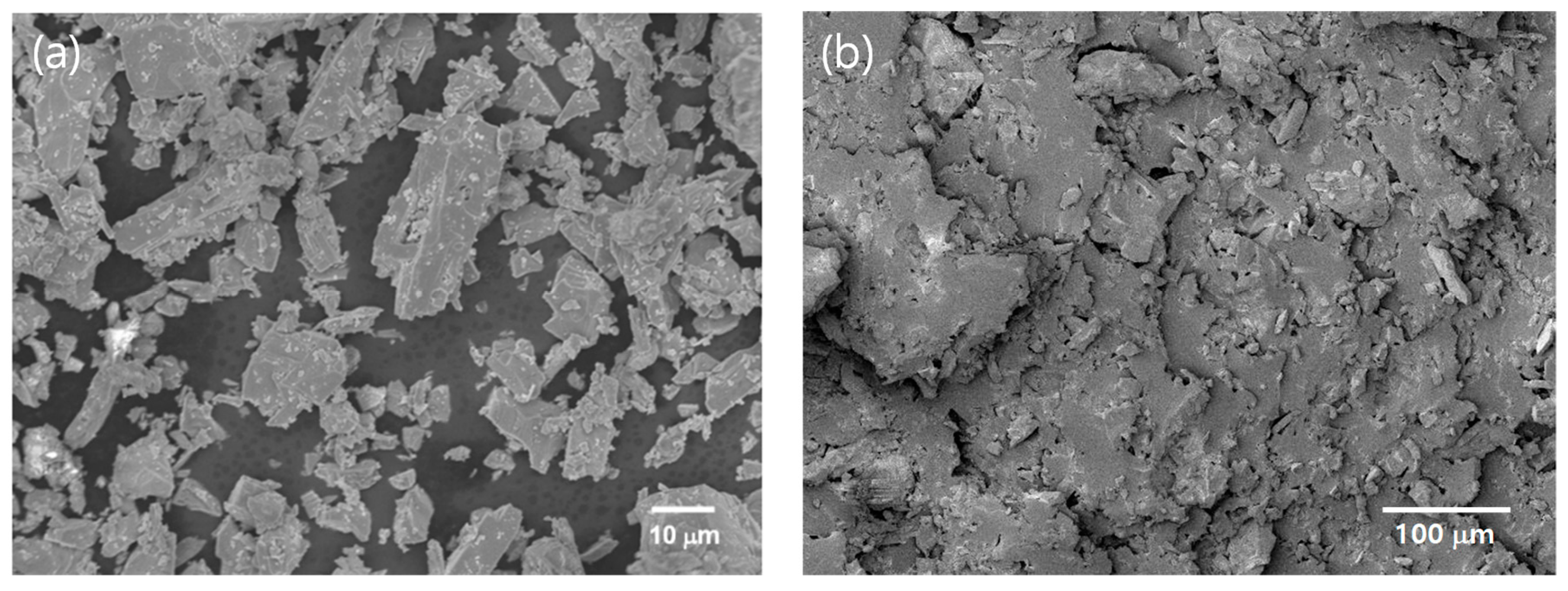
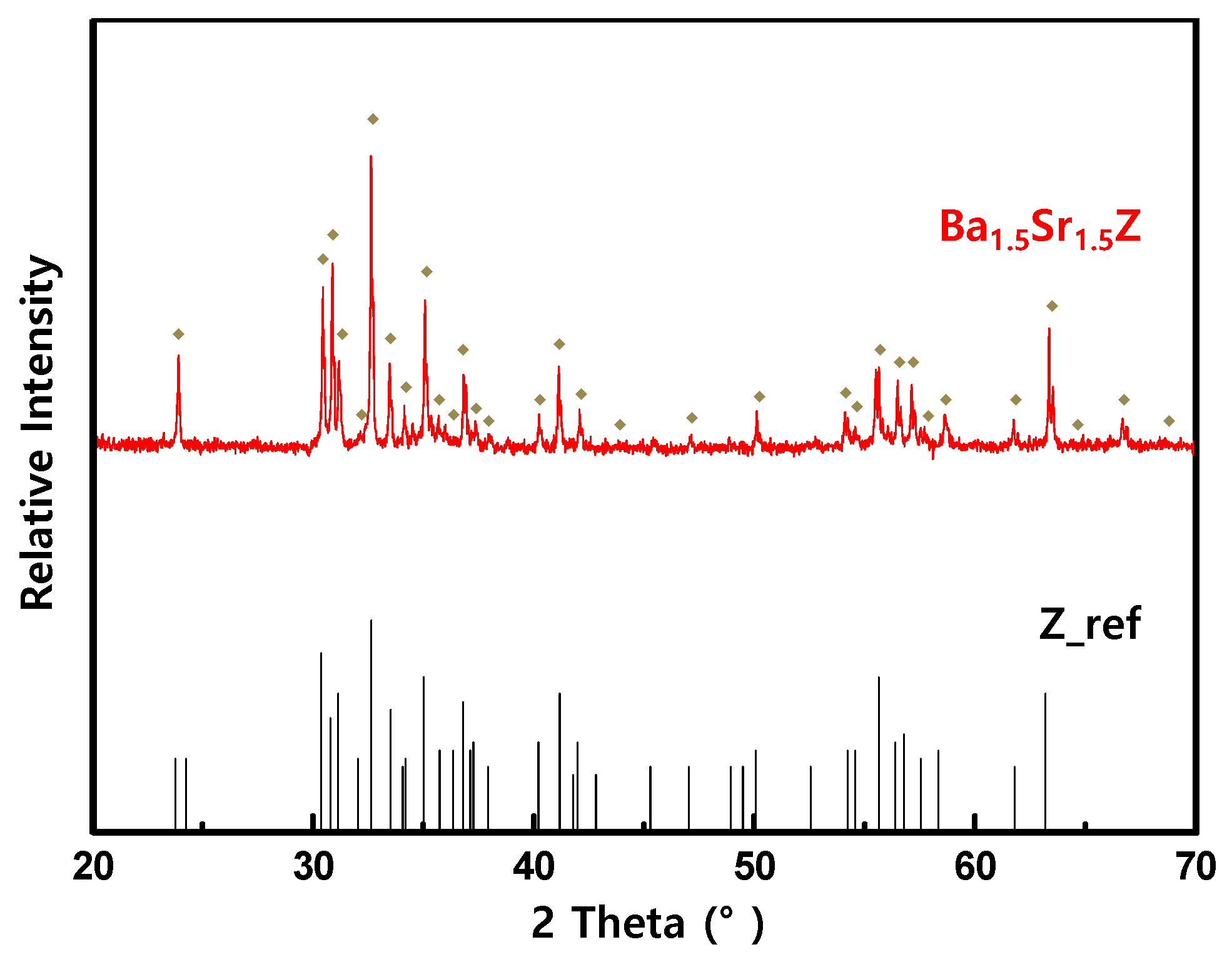
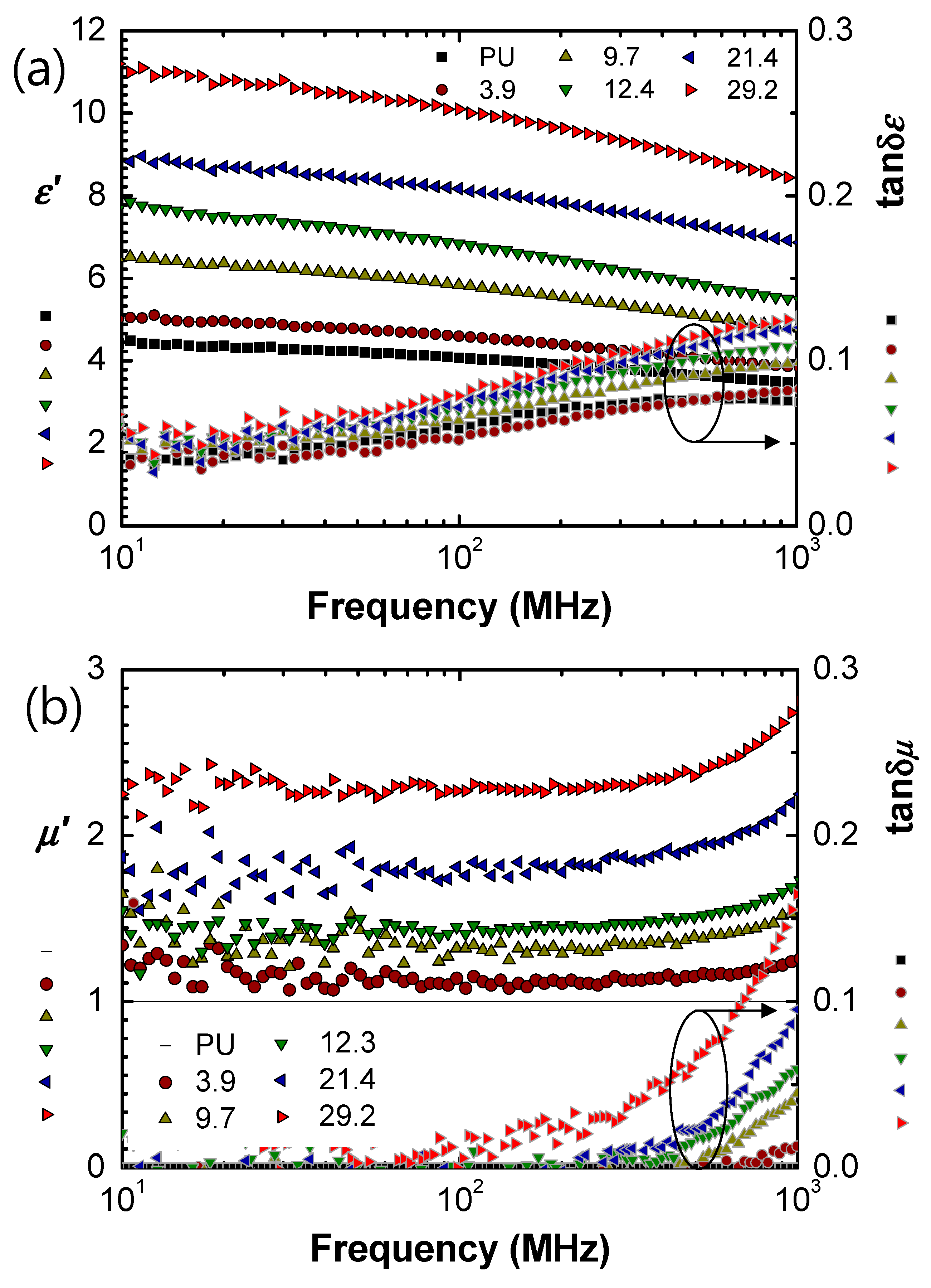
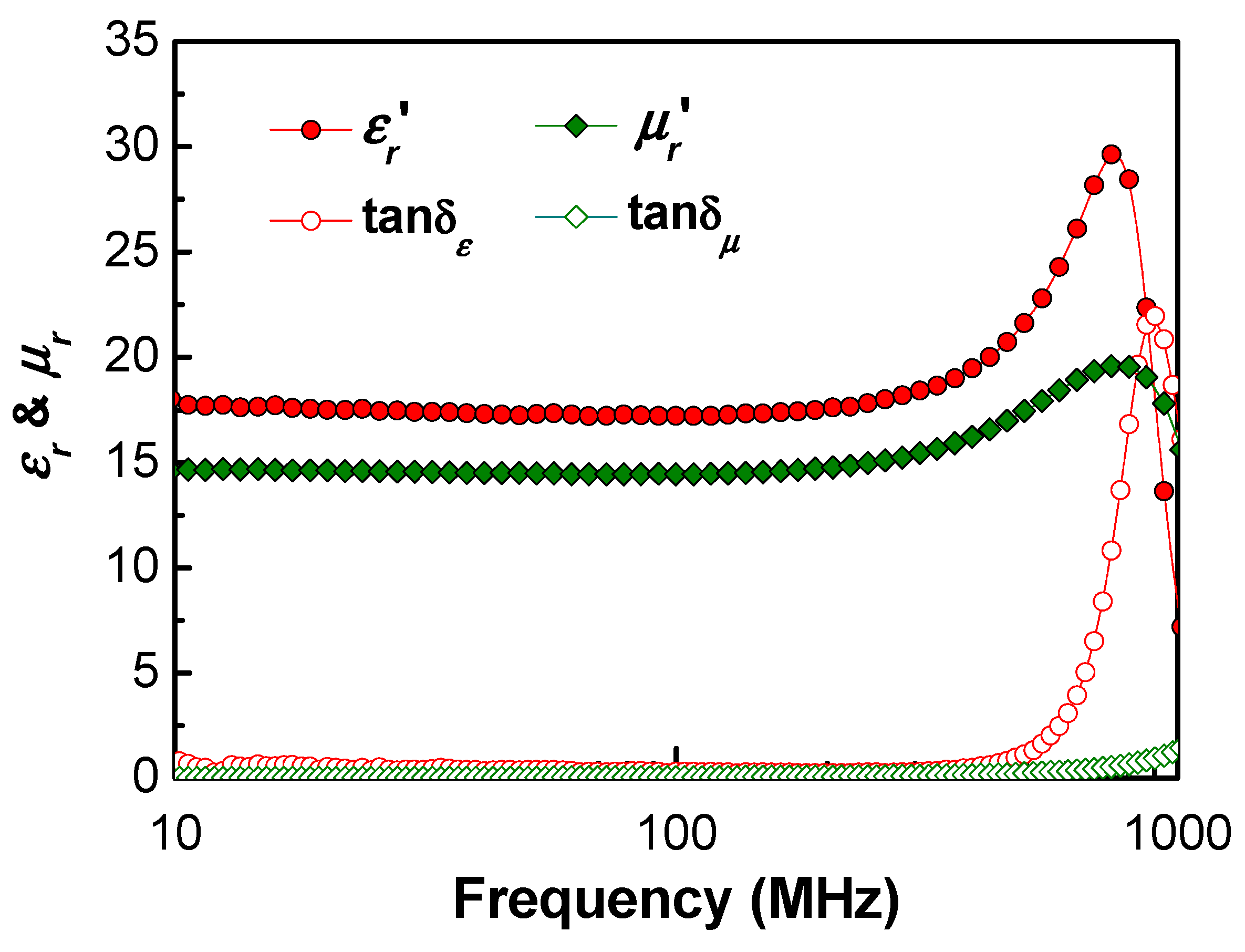
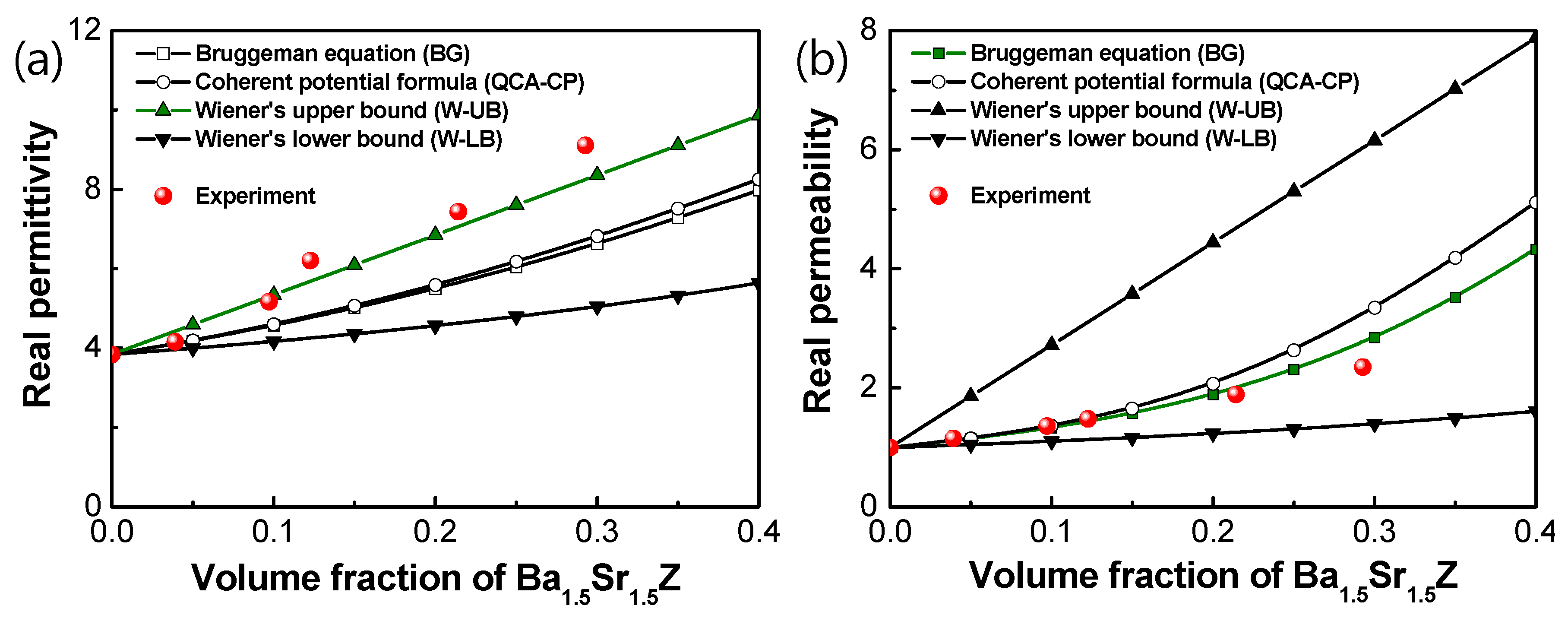


| Vf | μr′ | εr′ | (μr′εr′)1/2 | (μr′/εr′)1/2 | BW/BWε * | |
|---|---|---|---|---|---|---|
| MD | 03.9 | 1.2 | 4.2 | 2.2 | 0.53 | 1.2 |
| 09.7 | 1.4 | 5.2 | 2.7 | 0.52 | 1.4 | |
| 12.3 | 1.5 | 6.2 | 3.1 | 0.49 | 1.5 | |
| 21.4 | 1.9 | 7.4 | 3.7 | 0.51 | 1.9 | |
| 29.2 | 2.4 | 9.1 | 4.6 | 0.51 | 2.4 | |
| PD | - | 1 | 9.3 | 3.1 | 0.33 | - |
| Parameter (P) | Unit | MD | PD | Δ * |
|---|---|---|---|---|
| L (length) | cm | 12.5 | 13.1 | −4.6 (%) |
| A (area) | cm2 | 156.3 | 171.6 | −9.0 (%) |
| G (gain) | dB | −6.1 | −5.5 | −11.0 (dB%) |
| ηrad | dB | −12.8 | −12.3 | −4.1 (dB%) |
| BW | dB | 30.3 | 18.6 | 62.9 (%) |
© 2020 by the authors. Licensee MDPI, Basel, Switzerland. This article is an open access article distributed under the terms and conditions of the Creative Commons Attribution (CC BY) license (http://creativecommons.org/licenses/by/4.0/).
Share and Cite
Lee, S.-E.; Choi, S.P.; Oh, K.-S.; Kim, J.; Lee, S.M.; Cho, K.R. Flexible Magnetic Polymer Composite Substrate with Ba1.5Sr1.5Z Hexaferrite Particles of VHF/Low UHF Patch Antennas for UAVs and Medical Implant Devices. Materials 2020, 13, 1021. https://doi.org/10.3390/ma13041021
Lee S-E, Choi SP, Oh K-S, Kim J, Lee SM, Cho KR. Flexible Magnetic Polymer Composite Substrate with Ba1.5Sr1.5Z Hexaferrite Particles of VHF/Low UHF Patch Antennas for UAVs and Medical Implant Devices. Materials. 2020; 13(4):1021. https://doi.org/10.3390/ma13041021
Chicago/Turabian StyleLee, Sang-Eui, Seong Pil Choi, Kyung-Sub Oh, Jaehwan Kim, Sang Min Lee, and Kang Rae Cho. 2020. "Flexible Magnetic Polymer Composite Substrate with Ba1.5Sr1.5Z Hexaferrite Particles of VHF/Low UHF Patch Antennas for UAVs and Medical Implant Devices" Materials 13, no. 4: 1021. https://doi.org/10.3390/ma13041021
APA StyleLee, S.-E., Choi, S. P., Oh, K.-S., Kim, J., Lee, S. M., & Cho, K. R. (2020). Flexible Magnetic Polymer Composite Substrate with Ba1.5Sr1.5Z Hexaferrite Particles of VHF/Low UHF Patch Antennas for UAVs and Medical Implant Devices. Materials, 13(4), 1021. https://doi.org/10.3390/ma13041021






